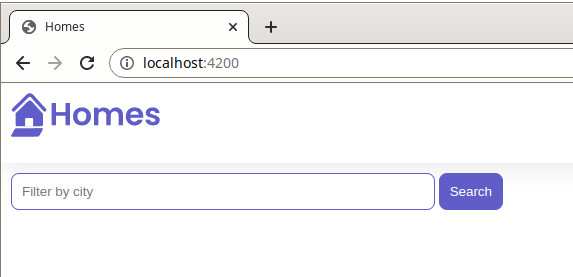Angular Javascript Frontend Framework - Part 3 (Home Component)
- Introduction
- What is a component?
- Create homepage component
HomeComponent - Add the new component to the app’s layout
- Add search elements to
HomeComponent
Introduction
This tutorial recaps the official documentation at https://angular.io/tutorial/first-app/first-app-lesson-02. For further information about components see https://angular.io/guide/component-overview.
In this part of our series we will create a new component for our Angular “Homes” app.
What is a component?
“Angular apps are built around components, which are Angular’s building blocks. Components contain the code, HTML layout, and CSS style information that provide the function and appearance of an element in the app. In Angular, components can contain other components. An app’s functions and appearance can divided and partitioned into components.”
Each component consists of:
- An HTML template that declares what renders on the page
- A TypeScript class that defines behavior
- A CSS selector that defines how the component is used in a template
- Optionally, CSS styles applied to the template
Until now our app contains only the component AppComponent, whose function is to contain all the other components.
The new HomeComponent we will create will display the home page of the app. Later on we will create more components to provide more features to the app.
In Angular, components have metadata that define its properties. When you create your HomeComponent, you use these properties:
selector: to describe how Angular refers to the component in templates.
standalone: to describe whether the component requires a ngModule.
imports: to describe the component’s dependencies.
template: to describe the component’s HTML markup and layout.
styleUrls: to list the URLs of the CSS files that the component users in an array.Components have other properties, but these are the ones used by HomeComponent.
Create homepage component HomeComponent
Open the VS Code terminal with “Terminal - New Terminal”. In terminal change to the apps directory and run the command to create the new HomeComponent:
$ cd tutorial-angular-homes
$ ng generate component Home --standalone --inline-template --skip-tests
CREATE src/app/home/home.component.css (0 bytes)
CREATE src/app/home/home.component.ts (303 bytes)
The new component is created in the new subdirectory src/app/home.
Code of home.component.ts:
import { Component } from '@angular/core';
import { CommonModule } from '@angular/common';
@Component({
selector: 'app-home',
standalone: true,
imports: [CommonModule],
template: `
<p>
home works!
</p>
`,
styleUrls: ['./home.component.css']
})
export class HomeComponent {
}
If app is not running, yet, issue ng serve.
When you browse to http://localhost:4200/ the app does not show any changes, because even though we added a new component, we haven’t included it in any of the app’s templates, yet.
Add the new component to the app’s layout
Now we add the new component HomeComponent to the app’s root component AppComponent, so that it displays in our app’s layout.
File src/app/app.component.ts
Import HomeComponent by adding to the file level imports:
import { Component } from '@angular/core';
import { HomeComponent } from './home/home.component';
In @Component section update the imports array property and add HomeComponent and update the template property to include the following HTML code:
@Component({
selector: 'app-root',
standalone: true,
imports: [
HomeComponent,
],
template: `
<main>
<header class="brand-name">
<img class="brand-logo" src="/assets/logo.svg" alt="logo" aria-hidden="true">
</header>
<section class="content">
<app-home></app-home>
</section>
</main>
`,
styleUrls: ['./app.component.css'],
})
The template includes the HomeComponent with tags <app-home></app-home>. The tag name is defined in src/app/home/home.component.ts in the component’s property selector:
@Component({
selector: 'app-home',
If ng serve is running, the app should update. If ng serve is not running, start it again. Hello world! in your app should change to home works! from the HomeComponent and the header section with a logo has been added:

Add search elements to HomeComponent
Now we will remove the static default text and add HTML for a search filter and a button that is used later on. For now, that’s all that HomeComponent has. Note that this just adds the search elements to the layout without any function, yet.
File src/app/home/home.component.ts
template: `
<section>
<form>
<input type="text" placeholder="Filter by city">
<button class="primary" type="button">Search</button>
</form>
</section>
`,
File src/app/home/home.component.css
.results {
display: grid;
column-gap: 14px;
row-gap: 14px;
grid-template-columns: repeat(auto-fill, minmax(400px, 400px));
margin-top: 50px;
justify-content: space-around;
}
input[type="text"] {
border: solid 1px var(--primary-color);
padding: 10px;
border-radius: 8px;
margin-right: 4px;
display: inline-block;
width: 30%;
}
button {
padding: 10px;
border: solid 1px var(--primary-color);
background: var(--primary-color);
color: white;
border-radius: 8px;
}
@media (min-width: 500px) and (max-width: 768px) {
.results {
grid-template-columns: repeat(2, 1fr);
}
input[type="text"] {
width: 70%;
}
}
@media (max-width: 499px) {
.results {
grid-template-columns: 1fr;
}
}
Final result:
